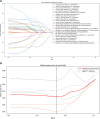Predicting the efficacy of chemoradiotherapy in advanced nasopharyngeal carcinoma patients: an MRI radiomics and machine learning approach
- PMID: 40641917
- PMCID: PMC12241078
- DOI: 10.3389/fonc.2025.1554899
Predicting the efficacy of chemoradiotherapy in advanced nasopharyngeal carcinoma patients: an MRI radiomics and machine learning approach
Abstract
Background: Machine learning methods play an important role in predicting the efficacy of chemoradiotherapy in patients with nasopharyngeal carcinoma (NPC). This study explored the predictive value of machine learning models based on multimodal magnetic resonance imaging (MRI) radiomic features for the efficacy in patients with advanced NPC after clinical chemoradiotherapy.
Methods: A retrospective analysis was conducted on data from 160 diagnosed patients with NPC confirmed by pathology at the First Affiliated Hospital of Bengbu Medical College. Patients were divided into effective group (n=116) and noneffective group (n=44) according to the Response Evaluation Criteria in Solid Tumors 1.1 (RECIST 1.1). After the overall Synthetic Minority Over-sampling Technique (SMOTE) sample balance, the proportion of effective group and invalid group is 1:1, both 116 cases, the total sample number is 232 cases. The region of interest (ROI) depicting the maximum solid component of the tumor on T2-weighted imaging short time inversion recovery (T2WI-STIR), contrast-enhanced T1-weighted imaging (CE-T1WI), and diffusion-weighted imaging (DWI) images was delineated, and radiomic features were extracted. Feature selection was performed through least absolute shrinkage and selection operator (LASSO) ridge regression, and based on the selected features, six machine learning models including random forest (RF), Extreme Gradient Boosting (XGBoost), support vector machine (SVM), logistic regression (LR), Light Gradient Boosting Machine (LGB) and K-nearest neighbor (KNN) were constructed. The model performance of the training set was verified by using the 5-fold cross-validation method, and the effect evaluation and performance visualization were performed on the test set. After that, the SHAP plot was established based on the feature weights, and finally the benefit degree of patients was analyzed using the DCA curve.
Results: A total of 3375 radiomic features were extracted, and 25 important features were selected after feature extraction to establish six machine learning models. The RF model exhibited the highest performance, achieving an AUC of 0.801, accuracy of 0.800, precision of 0.844, recall of 0.750, and F1 score of 0.794 within the test set. DCA results showed that patients could get good benefits.
Conclusions: The machine learning model based on multimodal MRI radiomic features may serve as a promising tool for predicting the efficacy of chemoradiotherapy in patients with advanced NPC.
Keywords: efficacy prediction; machine learning; magnetic resonance imaging; nasopharyngeal carcinoma; radiomics.
Copyright © 2025 Chen, Wang, Zhang, Meng, Wang, Zhao and Shen.
Conflict of interest statement
The authors declare that the research was conducted in the absence of any commercial or financial relationships that could be construed as a potential conflict of interest.
Figures






Similar articles
-
Machine learning-based radiomics for differentiating lung cancer subtypes in brain metastases using CE-T1WI.Front Oncol. 2025 Jun 19;15:1599882. doi: 10.3389/fonc.2025.1599882. eCollection 2025. Front Oncol. 2025. PMID: 40612349 Free PMC article.
-
Comparative analysis of tumor and mesorectum radiomics in predicting neoadjuvant chemoradiotherapy response in locally advanced rectal cancer.Diagn Interv Radiol. 2025 Aug 12. doi: 10.4274/dir.2025.253270. Online ahead of print. Diagn Interv Radiol. 2025. PMID: 40791107
-
Preoperative Prediction of Perineural Invasion in Pancreatic Ductal Adenocarcinoma Using Machine Learning Radiomics Based on Contrast-Enhanced CT Imaging.J Imaging Inform Med. 2025 Aug;38(4):1976-1985. doi: 10.1007/s10278-024-01325-1. Epub 2024 Nov 11. J Imaging Inform Med. 2025. PMID: 39528880 Free PMC article.
-
MRI-Based Radiomics Methods for Predicting Ki-67 Expression in Breast Cancer: A Systematic Review and Meta-analysis.Acad Radiol. 2024 Mar;31(3):763-787. doi: 10.1016/j.acra.2023.10.010. Epub 2023 Nov 2. Acad Radiol. 2024. PMID: 37925343
-
Magnetic resonance perfusion for differentiating low-grade from high-grade gliomas at first presentation.Cochrane Database Syst Rev. 2018 Jan 22;1(1):CD011551. doi: 10.1002/14651858.CD011551.pub2. Cochrane Database Syst Rev. 2018. PMID: 29357120 Free PMC article.
References
LinkOut - more resources
Full Text Sources

